Looking at rice
(I've updated this very popular post with some info about germ rice (haiga-mai) and sprouted brown rice (hatsuga genmai). In case you missed it the first time around, here it is again in your RSS reader and on the front page.)
Rice is a big part of my food life. While I do like other kinds of carbohydrates, especially good bread and pasta, rice is definitely my favorite.
There are so many different kinds of rice though. Even if one leaves out the rather more exotic kinds like red rice from the Camargue, American wild rice (which is not actually a rice but a kind of grain) or black rice (kokumai), I usually have on hand several different kinds of rice, each with a different use. Here are the ones I have in the pantry right now that I use in everyday cooking.
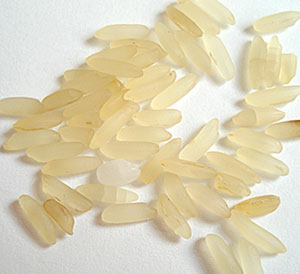 This is the long grain, parboiled rice, the kind that is most commonly used in European and American cooking. The grains don't stick together, for that separate, 'fluffy' texture that American/UK cookbooks find desirable. To me this is the most boring kind of rice with little character of its own. Nevertheless it is the least expensive kind of rice usually, and has its uses. I use this for rice dishes that have a lot of added flavor, like pilafs or fried rice. It can not be used as a substitute for japonica rice in most traditional Japanese dishes, since it is it not sticky enough.
This is the long grain, parboiled rice, the kind that is most commonly used in European and American cooking. The grains don't stick together, for that separate, 'fluffy' texture that American/UK cookbooks find desirable. To me this is the most boring kind of rice with little character of its own. Nevertheless it is the least expensive kind of rice usually, and has its uses. I use this for rice dishes that have a lot of added flavor, like pilafs or fried rice. It can not be used as a substitute for japonica rice in most traditional Japanese dishes, since it is it not sticky enough.
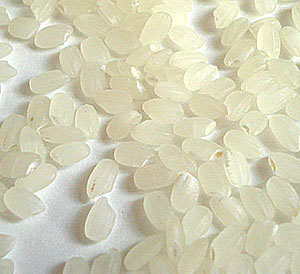 This is Japanese-style rice, or uruchi-mai - the kind of rice I talk about the most on this site. It is also sold as medium grain rice, or sushi rice. It's the rice to use for almost any kind of Japanese dish, including the all-important sushi and onigiri. The rice grains cling together without being mushy when properly cooked. This rice must be polish-washed to bring out its best flavor, as I have previously described. The best kinds of this rice have a translucent quality and have clean, rounded grains. As you can see, the grains are rounder compared to long-grain rice.
This is Japanese-style rice, or uruchi-mai - the kind of rice I talk about the most on this site. It is also sold as medium grain rice, or sushi rice. It's the rice to use for almost any kind of Japanese dish, including the all-important sushi and onigiri. The rice grains cling together without being mushy when properly cooked. This rice must be polish-washed to bring out its best flavor, as I have previously described. The best kinds of this rice have a translucent quality and have clean, rounded grains. As you can see, the grains are rounder compared to long-grain rice.
A variation of white uruchimai is haigamai (germ rice, 胚芽米). It's hulled and polished white rice with the germ left intact. This is a bit more nutritious than regular white rice. This is getting more available at Asian/Japanese groceries.See this excellent tutorial on Instructables for how to sprout brown rice.
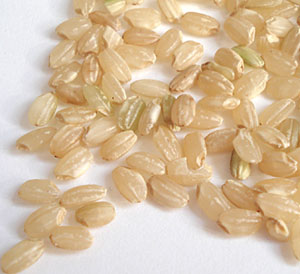 This is gen-mai, the brown version of uruchi-mai. It requires more water and a longer cooking time than the polished version. If you are in the market for a new rice cooker you may want to look for one that can cook brown rice. I've been eating more of this instead of the polished rice recently. Since the bran that is on brown rice contains oils that can turn rancid, it should be as fresh as possible. (Update: how to cook brown rice in a pot on the stovetop.)
This is gen-mai, the brown version of uruchi-mai. It requires more water and a longer cooking time than the polished version. If you are in the market for a new rice cooker you may want to look for one that can cook brown rice. I've been eating more of this instead of the polished rice recently. Since the bran that is on brown rice contains oils that can turn rancid, it should be as fresh as possible. (Update: how to cook brown rice in a pot on the stovetop.)
One way to process brown rice, which is supposed to make it much more nutritious, is to let it germinate or sprout. This turns it into hatsuga genmai (literally, "sprouted brown rice", 発芽玄米, also known as GBR in health-food/vegan circles). To sprout rice on your own, soak it in lukewarm water for 24 hours, and keep it in a warm place (I keep mine on top of the hot water tank). At the end of the 24 hours, you may see the end of the grains are splitting a bit, and evena tiny little white root peeking out - that means it's sprouted. If it hasn't sprouted yet, rinse the grains and cover again with lukewarm water. If it still hasn't sprouted by the end of another 24 hours, it probably never will, so you can just cook it before the grains start fermenting actively. Since the grains have been soaked for so long you can cook it as you would white rice (in a rice cooker for example). It is softer and supposed to be easier to digest than regular brown rice.
You can also purchase sprouted rice - look in health food stores.
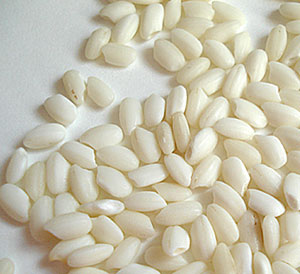 This is mochi-mai, or mochi rice, otherwise called sweet rice, short-grain rice, or sticky rice. The grains are not really that much shorter than the "medium-grain" uruchi-mai above but as you can see, the grains look quite different. The are opaque and white rather than transculent. This is beaten and kneaded to make glutinous mochi cakes, used to make osekihan (red rice with beans), or used for some sweets.
This is mochi-mai, or mochi rice, otherwise called sweet rice, short-grain rice, or sticky rice. The grains are not really that much shorter than the "medium-grain" uruchi-mai above but as you can see, the grains look quite different. The are opaque and white rather than transculent. This is beaten and kneaded to make glutinous mochi cakes, used to make osekihan (red rice with beans), or used for some sweets.
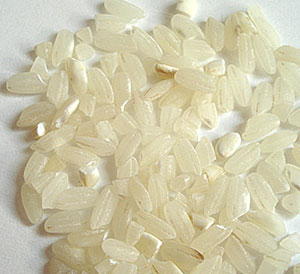 This is vialone rice from Italy. I use this or arborio rice for making risotto. It actually looks quite similar to uruchi-mai or japonica rice. These medium grain Italian rices can, a pinch, be used instead of Japanese rice. This is useful to know if you live in an area where vialone, arborio and other Italian rice varieties are cheaper than Japanese rice (which is certainly the case in Switzerland...we are a lot closer to Italy than to Japan after all). The reverse holds true too - if you have more or easier access to Japanese rice than arborio, vialone or carnaroli, you can use that, unrinsed, for risotto. When used for Italian dishes rice is not rinsed, since the powder that clings to the grains is the substance that makes risotto creamy.
This is vialone rice from Italy. I use this or arborio rice for making risotto. It actually looks quite similar to uruchi-mai or japonica rice. These medium grain Italian rices can, a pinch, be used instead of Japanese rice. This is useful to know if you live in an area where vialone, arborio and other Italian rice varieties are cheaper than Japanese rice (which is certainly the case in Switzerland...we are a lot closer to Italy than to Japan after all). The reverse holds true too - if you have more or easier access to Japanese rice than arborio, vialone or carnaroli, you can use that, unrinsed, for risotto. When used for Italian dishes rice is not rinsed, since the powder that clings to the grains is the substance that makes risotto creamy.
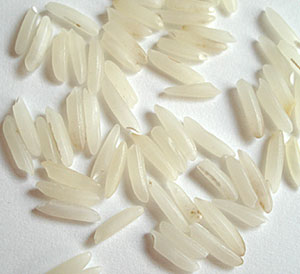 The final kind of rice that is a staple in our house is basmati rice. It has the longest grain of all, and a translucent appearance. It also has a a distinctive sort of spicy aroma, which matches spicy dishes perfectly. I keep this on hand of for Indian and Thai type dishes. I often have Thai 'perfume' or 'jasmine' rice on hand too, which is quite similar in cooking qualities. Neither basmati or jasmine rice can be used successfully in traditional Japanese dishes such as onigiri or sushi, since they are not sticky enough.
The final kind of rice that is a staple in our house is basmati rice. It has the longest grain of all, and a translucent appearance. It also has a a distinctive sort of spicy aroma, which matches spicy dishes perfectly. I keep this on hand of for Indian and Thai type dishes. I often have Thai 'perfume' or 'jasmine' rice on hand too, which is quite similar in cooking qualities. Neither basmati or jasmine rice can be used successfully in traditional Japanese dishes such as onigiri or sushi, since they are not sticky enough.